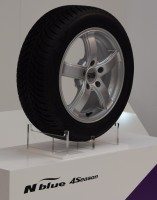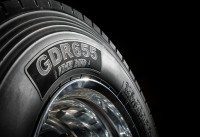A solution the market is waiting for – VMI presents automated Retrax tyre builder
Retreading is a concept that not only deserves to succeed, but should also be praised for reducing raw material consumption without compromising on the end product’s performance. Yet European retreaders can vouch that nobody is pinning medals to their chests; their ‘reward’ for giving valuable truck tyre casings a second or third life has instead been declining sales at the hands of low-cost and possibly subsidised imported new tyres, products that more often than not are used until the original tread is worn and then simply discarded. But has Europe’s retreading sector arrived at a place where it is ready to stage a fightback? Machinery manufacturer VMI believes it has.
“The availability of cheap new tyres has made retreading a difficult business in Europe, and in light of this we’ve been thinking about a new retreading solution for a number of years,” comments Dirk Reurslag, sales director for industrial solutions and services at VMI. When Tyres & Accessories spoke with Reurslag last year, he hinted that a new extension to the Retrax programme was in development. These products, Retrax machines that combine a cushion gum extruder, automatic builder and automatic stitcher together in the same unit, are now on the market and on display at the Reifen show this week. Retrax is available in a range of specifications, with the highest-output units capable of producing up to 165 retreads per eight hour shift.
VMI favours the smearing technique of cushion gum extrusion and has used it in this latest Retrax builder as it offers the benefits of strip winding – the highly tacky gum is freshly extruded, one single feeding strip feeds to the extruder, and operators can guarantee first in first out with their stock material – with the added advantage that repairs to the buffed casing don’t need to be performed as precisely, as all holes 5mm or less are smeared closed by the smearing effect.
But what really sets the new Retrax machine apart from the competition is the extent to which operators are relieved of the task of calculating specific measurements. “The machine itself works out the tyre circumference and the length of the tread, and it calculates automatically what stretch of cushion gum to apply,” explains Reurslag. “And at the end you have a perfect splice. The operator doesn’t need to enter any specific data – we’ve developed a system that thinks for itself.”
Applying the stretch correctly is key to tread application, and according to Reurslag, Retrax performs this task in a way similar to how a manual retreader would do it. “We studied how operators applied the stretch – they measure first and then think ‘I have to pull this much’ – this kind of decision is now automated. The system applies a stretch of nearly 330 degrees around the tyre and makes a perfect splice. The extension is then released before it goes through the autoclave.”
The machinery manufacturer has now sold more than 1,400 machines that utilise the smearing principle. Most units operate in North America and Europe, however sales are increasing in Asia. “There is great potential in Asia, and this is something VMI has its eyes on,” comments Reurslag. “It is currently a small and slowly growing retreading market, nevertheless we see many possibilities there.” But the sales director for industrial solutions and services quickly adds that it isn’t only retreaders in emerging markets that stand to benefit from Retrax.
“I believe this will help retreaders in Europe retread more competitively. The number of retreaders here decreases every year, and we now see that most of those who remain are those with sufficient volumes to warrant making investments, and these companies are now looking for solutions. This is the point where their requirements and what we can offer them intersect.”
While Reurslag concedes that the mould cure process results in a more aesthetically pleasing retread, it is more complicated than pre-cure retreading and requires a higher output volume to justify the investment cost. High volumes usually mean centralised production, and this in turn means an increased distance to market and higher transportation costs.
“Therefore we believe pre-cure will prevail in the future,” Reurslag concludes. “Retrax gives us the chance to make pre-cure as high-quality as possible. With this new solution, which applies the pre-cure tread with a high degree of accuracy, we think we really have a solution that the market is waiting for.”




Comments